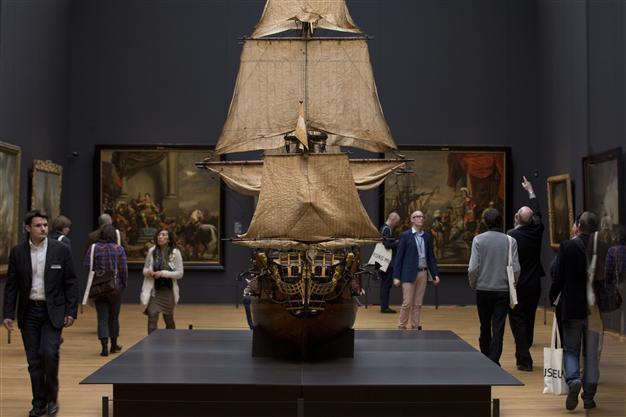Renewed Rijksmuseum revamps the Golden Age
AMSTERDAM - Agence France-Presse

Visitors admire a 1698 model of the late 17th century Dutch warship William Rex during a press preview of the renovated Rijkmuseum in Amsterdam, Thursday, April 4, 2013. AP Photo
Amsterdam's world-famous Rijksmuseum revealed its new 21st century identity Thursday after a vast 10-year, 375-million euro (480-million dollar) renovation aimed at breathing new life into its unparallelled collection of Golden Age masterpieces."The Rijksmuseum stands at the threshold of a new page of its history," the 19th-century museum's general director Wim Pijbes told journalists at a press preview of the revamp, masterminded by Spanish architects Cruz y Ortiz.
Architects and artisans have restored much of the original styling of the Gothic-Renaissance building, designed by Pierre Cuypers and first opened in 1885, but with extensive modern touches.
The museum covers 800 years of Dutch history through 8,000 objects, distributed through 80 rooms. A one mile (1.5-kilometre) walk around the galleries will take you "from the Middle Ages to Mondrian." But at the heart of the museum's physical and artistic identity is Rembrandt's vast masterpiece of militia intimidation, The Night Watch. The painting symbolises the Golden Age, roughly spanning the 17th century, when the Dutch dominated much of world trade and, as a result, art.
Spectacular newfound bourgeois wealth meant that millions of paintings were commissioned, often portraits or landscapes, rather than the romanticised Biblical imagery that had dominated the Italian Renaissance.
The Protestant Dutch spent the first half of the Golden Age fighting for liberation from the Catholic Spanish, and it is not without irony that Spanish architects have now renovated the world's foremost Golden Age treasure trove.
The museum hopes to draw two million visitors a year, "binding people, art and history," according to director Pijbes.
"Everything has changed except for one thing, The Night Watch -- although it's now hanging a little bit higher than before," he said.
Director of collections Taco Dibbits summarised the museum as being about a "feel for beauty and a consciousness of history".
While previously a museum such as the Rijksmuseum would have a room for paintings, a room for furniture and a room for ceramics, Dibbits said, that has now changed.
Instead, Rembrandt's paintings now hang alongside furniture made by Herman Doomer, a cabinetmaker friend of his, or a portrait of Golden Age poet Constantijn Huygens, who wrote about Rembrandt.
The objects live happily together, either hung on walls or housed in what Dibbits called "nearly invisible" cases.
But the renovation has not been without controversy, running massively over budget and deadline.
One particularly Dutch headache has been a bicycle path running through a tunnel in the middle of the building. The museum didn't want the tunnel used as a bike path because of its proximity to the entrance, but the city authorities decided to let the bikes through and monitor the situation. It was even suggested at one point that Amsterdam hold a referendum on the typically Dutch and divisive issue.
During the renovation, 400 of the museum's works were moved into the Philipsvleugel wing, where they were seen by 8.5 million visitors over nine years.
Other works were to be seen in rotating exhibitions at the museum's annex at Amsterdam's Schiphol airport, which has been there for over 10 years.
Former Dutch football international Ruud Gullit, whose mother used to work at the museum, has starred in adverts for the Rijks, in the hope of drawing more Dutch visitors, with more than 40,000 advance tickets already sold online.
It is the museum's ambition for every Dutch child aged 12 or 13 to have seen the Night Watch, director Pijbes said, and for half of visitors to be Dutch.
Queen Beatrix is to officially reopen the museum to the public on April 13, when entrance will be free, in her last major public appearance before she abdicates in favour of her son Willem-Alexander on April 30.
















